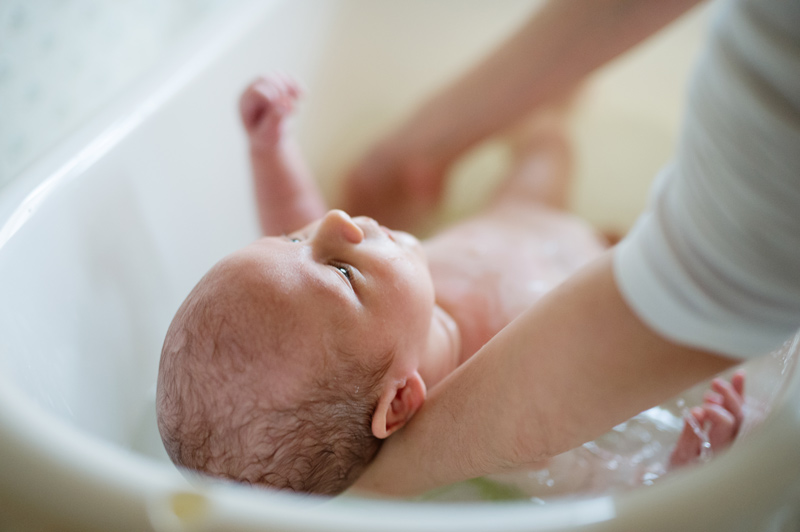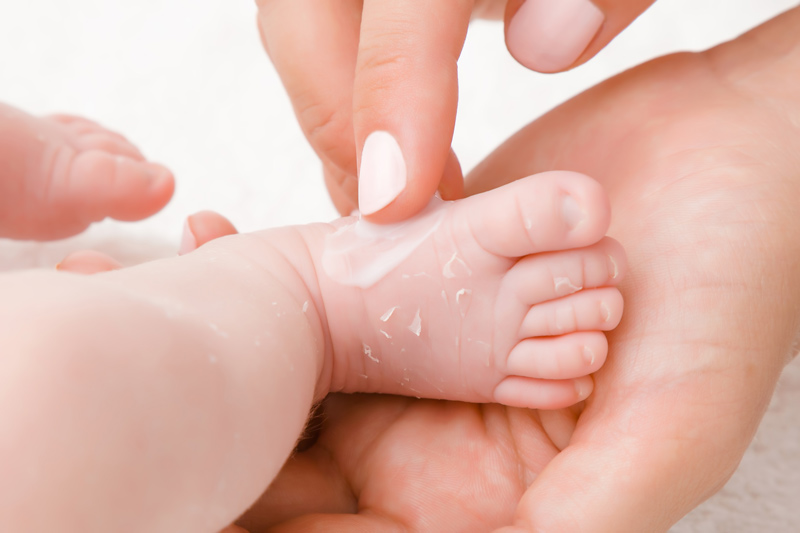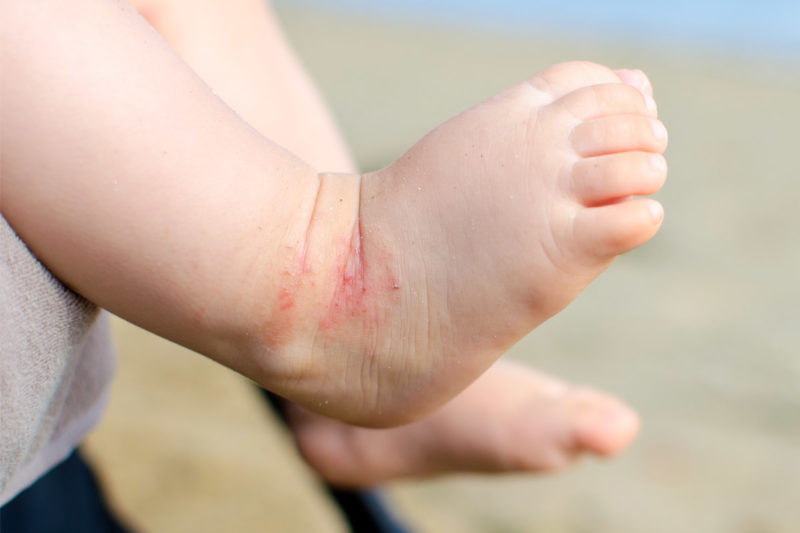From babies with flushed cheeks to children who can’t bend their knees without discomfort, and scratch frantically at the crooks of their arms… 20% of children under the age of 7 and 15% of babies aged 3 months and up (French Dermatology Society figures) suffer from atopic dermatitis, the scientific name for eczema. So what solutions are there to help them feel better?
What is eczema (AKA atopic dermatitis)?
According to its official definition, atopic dermatitis – AKA atopic eczema – is a chronic inflammatory skin disease caused by an abnormal immune response and a deficient skin barrier.
What triggers eczema?
Like many chronic skin conditions, eczema is caused by multiple factors. There’s a genetic factor in that between 50% and 70% of affected children have a parent who is also affected, and if both parents are affected, there is an 80% chance that their child will be. There’s also an immune factor (heightened reactivity to certain pathogens and allergens) and an environmental factor (including pollution).
Why is that? Well, healthy skin forms a defensive barrier against external agents, but skin affected by atopic dermatitis lacks ceramides in its stratum corneum. Like a wall with holes in it, it allows assailants (pathogens and allergens) to get through and defenders (hydration) to get away.
How do you deal with eczema?
As soon as the first symptoms appear, it is essential to consult a dermatologist. They will prescribe a treatment (corticosteroids for local application during flare-ups), and will also be able to see if there is an underlying atopic tendency. Because atopic dermatitis is considered the skin disorder manifestation of atopy, which also includes allergic asthma, allergic rhinitis and allergic conjunctivitis.
What are the symptoms of eczema?
Atopic dermatitis is characterised by permanent skin dryness, with regular flare-ups of what is commonly called eczema, most often interspersed with teething pain, nose and throat infections in infants. Red patches and inflamed lesions (erythema and vesicles) appear, coupled with severe itching. Over time, scratching may lead to superinfections. The formation of scabs indicates the beginning of the subsidence phase.
In infants, these patches are located on the cheeks, arms, thighs and abdomen.
Later in life, in children and teenagers, they appear in skin folds (the backs of the knees, crooks of the elbows), on the hands and feet, around the mouth and even on the eyelids. Eczema flare-ups can be related to an infection or vaccination, and also to stress (exam stress, upheaval in the family, etc.) For many, atopy is something that they grow out of (like asthma) after the age of six, but they still have dry skin. 4% will go on to still have atopy in adulthood.
Atopy can range from mild to severe, and there is a scale used by dermatologists to assess it, called the SCORAD (or SCORing Atopic Dermatitis).
The impact of eczema
Along with acne, atopic dermatitis is among the skin conditions that have the greatest impact on social development. Incessant itching can cause severe psychological distress. This itching, which carries on through the night, can wreck an infant’s sleep and life, and in turn those of the whole family. School children sometimes feel sidelined, because of the way their classmates stare at them. Some even try to hide their legs or arms under clothes, or are unwilling to go to school. Lastly, the itching sensation is so troublesome that it can cause irritability and bad moods. The damage to self-image is also exacerbated in teenage girls with eyelid eczema, who can’t wear eye make-up.
The skincare products to use and the right routines to follow
The treatment prescribed by dermatologists and paediatricians is based on dermocorticoids in case of a flare-up, to be used in local application for an average of 3 days.
But dermatologists have noted that with the right skincare products and routines, the frequency of flare-ups can be much reduced.
Gentle cleansing

This should be done with a cleansing oil or a dermatological bar. Soap and standard shower gel are far too harsh and caustic. Avoid long hot baths, which increase the permeability of the skin. Instead, take a five-minute lukewarm shower. After showering or washing your hands, dab the skin with the softest towel possible and whatever you do, don’t rub. Your skin is already fragile enough!
Daily hydration

The best treatment for atopic skin is the daily application of a specific emollient. Their long-term use not only has a beneficial effect on skin dryness, but studies have shown that it decreases the frequency of flare-ups and therefore of dermocorticoid use. These emollients must have a high proportion of nourishing plant oils and butters, soothing active ingredients and even antibacterial ingredients, to prevent the proliferation of staphylococcus aureus.
The drawback is that it’s a hassle, because even though the formulations have moved on a great deal in terms of naturalness and texture, they are still quite thick and you’ll often find yourself chasing after the children to get it onto them. But this is a habit that you should get them into from an early age, using a song, story or game to make it fun. Because these children will have to learn to apply the cream themselves, their whole life long. There are also therapeutic education programmes in hospitals to teach young patients how to care for themselves independently.
The right habits
- Something to teach infants: during flare-ups, don’t scratch with your nails, which are sharp and can carry germs, but with the palm or back of your hand
- As for clothes, favour loose-fitting ones to limit rubbing against the skin, and cotton or silk in preference to wool
- Thermal spa therapy: three-week thermal spa treatments, which are prescribed by a doctor and reimbursed by health insurance here in France, have proven effective against disorders such as atopy. In addition to the general hydrothermal treatments (baths, showers, massages) and daily local treatments offered, they are places for therapeutic education and interaction through games and workshops for the younger ones. This allows young children to get relief from their symptoms and become more independent. About ten thermal spas across France are indicated for skin conditions.
What to avoid in case of atopic dermatitis
As atopic skin is fragile and porous, it is essential to be extra careful about the beauty products you use and their ingredients. Watch out, because a lot of blogs, articles and so on slam certain beauty products, not least standard ones, but sometimes promote products that are just as bad for this skin type.
Ingredients that are off limits
- Fragranced beauty products: whether synthetic or natural, those with hypersensitive skin should avoid them, as there are as many allergens in a natural perfume as in a synthetic one, if not more.
- Preservatives: potentially irritant or allergenic: MIT and MCIT are to be avoided, as they are irritant, as is benzoic acid, which is allowed in organic products.
- Sulphates, the foaming agents in most conventional shower gels, are too harsh for this skin type. They disrupt conditions for the microbiota and hydrolipidic film.
- Soap: OFF LIMITS! Except unfragranced cold-process soap, with a high oil content, of the highest quality, i.e. a soap bought from a small soap maker costing more than €10. Forget mass-produced soap, including Marseille soap, as it is very caustic and has far too high a pH!
- Lanolin: derived from the oil in sheep’s wool, it is highly allergenic. However, it is almost never found in specific emollients for atopic skin.
- Endocrine disruptors: obviously, you’ll want to avoid them like everyone else, but again, they are difficult to spot, while many brands are dropping them. It goes without saying that products with a clean charter are preferable, and those labelled “dermatologically tested” or even “paediatrically tested” best of all.
A healthy environment
Use hypoallergenic laundry detergent for the atopic person’s clothes and also bedlinen, to avoid all surfactants and fragrances. Also be sure not to use fabric softener, since it gets released into the final rinse water.
Avoid all household upkeep products and furniture containing volatile organic compounds (VOCs): construction, decoration and insulation materials, paints, thinners, glues and varnishes, and also cleaning agents, air fresheners, stain removers, insecticides and descalers.
The microbiota, a way forward for atopy
Advances in knowledge about what we used to call skin flora have shown that the diversity and balance between the microorganisms that make up the microbiota prevent us from playing host to hostile species and contribute to the skin’s immune defences. And we now know, thanks to a study published in the journal Nature, that atopic dermatitis is closely linked to a serious imbalance in these microbiota and to the overgrowth of staphylococcus aureus within them. It binds to the skin and forms a shield that serves to ramp up eczema flare-ups, dryness and itching. Corticoids are still the benchmark treatment, but the merit of developing emollients enriched with active ingredients (pre- and postbiotics), is becoming apparent. These help to rebalance the microbiota, reduce the inflammatory factor and prevent staphylococcus aureus from taking hold. To counter this, some brands have developed pre- and post-biotic complexes.
Diet
Breastfeeding babies up until the age of 6 months reduces their risk of developing food allergies, especially if there is a history of atopic dermatitis in the family. It is better to introduce certain foods later, such as eggs and fish (12 months and up) and oilseeds (after the age of 3), and only do so one at a time.
Although atopic dermatitis is not linked to any particular food, some foods can exacerbate it, especially those that have a pro-inflammatory action or promote acidity in the body. Thus, acidic sweat can promote flare-ups. Therefore you have to favour an alkaline diet (fruits, vegetables, legumes and whole grains). Plants, which are high in antioxidants, help combat inflammation. Obviously, you have to eat a balanced diet, avoid sugary and processed foods, saturated fats (heated butter and margarine, cold cuts, fried food, crisps, etc.) and junk food. Some people with atopy also suffer from irritable bowel syndrome, which tends to acidify the body. In that case, it’s best to avoid eating starchy foods / fruit and vegetables in the same meal. In addition, see if the symptoms ease off when you cut out gluten and cow’s milk products. And also, because atopy is linked to dysbiosis of the microbiota, and because the gut microbiota and skin microbiota are closely linked, eating foods high in pre- and probiotics, including all fermented foods (yaourts, kefir, kombucha, etc.) You can also add to this diet high in fermented foods with dietary supplements high in probiotics.







